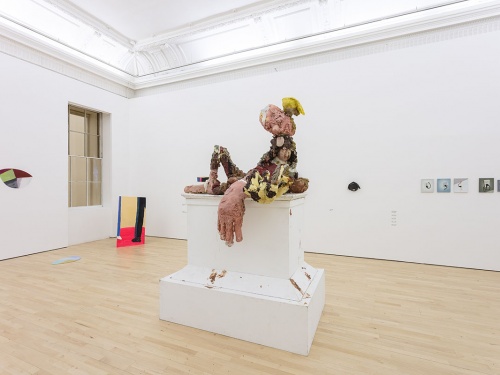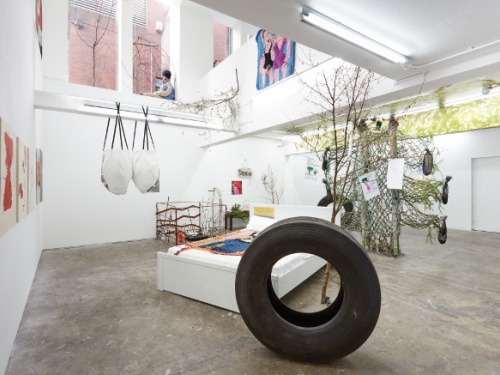Keep Tomorrow Free: David Robilliard at the ICA
It's the last week to see David Robilliard: The Yes No Quality of Dreams here at the ICA - the exhibition closes on Sunday at 6PM. In an exclusive for the ICA Blog, arts writer Chloë Ashby takes a look at Robilliard's work and his impact on the London art scene.
A self-taught poet and painter who died of AIDS in 1988, David Robilliard (1952-1988) was a darling of the underground scene in London the 1980s. Although the Stedelijk Museum Amsterdam held a major retrospective of his work in 1993, and a sprinkling of shows followed, by the mid 90s Robilliard’s moment had passed - the YBAs were charging ahead, and nobody seemed inclined to look back.
He began his career in the early 1970s when he moved to Hoxton, in East London. He came to prominence in Thatcher’s England, having thrown himself wholeheartedly into the East End’s alternative and radical avant-garde scene. In 1979 he met artist collaborators Gilbert & George - long-term supporters who described him as “the new master of the modern person”. He had shows at the city’s hottest hangouts—Soho’s L’Escargot, for one—and he contributed poems to cutting edge underground magazines like The Fred and Square Peg.
Rather than include archive material such as his postcard poems and books, the ICA have chosen to show only Robilliard’s paintings. They’ve gathered twelve canvases from nine different venues; the Tate’s The Yes No Quality of Dreams inspired the title of the show. It’s a very purist approach, but nothing’s lost: in the words of ICA Executive Director Gregor Muir, “Robilliard’s paintings are his poetry”.
Upon entering the double gallery space—Keep Tomorrow Free occupies the hallway between two light-filled rooms, a fitting welcome to the show—gallery-goers are happily met with¬ bright white walls highlighted with dashes of colour. Robilliard’s perspective is undeniably logo-centric: words cut across his paintings in blocky handwritten letters. His quirky one-liners are pithy and direct. Muir explains the lack of pretence: “Robilliard’s a natural at being naturally himself”. Perhaps it’s thanks to his lack of formal training: he wasn’t complicated by formalities or constricted by a particular style.
The paintings deliver brutally honest day-to-day observations about a world, as Muir puts it, “seen from the bottom of a pint glass in a gay bar”. Robilliard was a man who fell in love, had fallouts and sometimes was simply puzzled by it all; his lyrical yet deadpan works catalogue life’s pains and delights.
The poems precede the paintings. Scrawled words on scrunched-up paper (Robilliard’s pockets were forever full of crumpled notes) were his starting point. Muir suggests the artist’s thoughts came to him “at the craziest of times … the morning after … they’re like minutes of the madness of the night before.”
There’s a doubleness to his works: a childlike naiveté—unmixed primary colours on blank canvases, crude handwriting, doodle-like figures—paired with life experience; the wise (if wry) words flesh out fragmented character sketches. All of the above is proudly titled, dated and signed directly on the surface of the work; the signature too, childishly direct yet with a mature confidence in its bold stamping, can be read in different ways.
Robilliard’s work is playfully coded. A lot of the subject matter is sexual, tongue-in-cheek innuendo or queerspeak: Too many cocks spoil the breath. The cryptic messages echo knowing looks exchanged in a bar. Occasionally it’s about the need to disguise gay behaviour, at a time when homosexual activity had only recently been decriminalised. The idea of being a poet in the East End, and a queer poet at that, was a precarious position to occupy. In The Naked Flame, Robilliard gives us a glimpse of his insecure perch: it could be a smiling self-portrait that asks, “Do you love like a pidgeon or a like a poet?”
Life Isn’t Good It’s Excellent is surprisingly optimistic - a beacon amidst the melancholy. More often than not, Robilliard seems let down in love: Disposable Boyfriends says it all. Yet there’s more to the downbeat tone than the cynical Box of tricks – my ass suggests. All twelve of the paintings on show were created between 1987 and 1988, at a time when London was ravaged by AIDS. Robilliard contracted HIV and died in 1988 at the age of 36. As the disease loomed large on the horizon, his poems developed and evolved; no wonder then, the haunting nature of some of these later compositions, their outlook unapologetically glum.
Robilliard paved the way for a rejection of conservative patterns in British art and inspired a contemporary outlook. He can be connects to the YBAs who followed him—to Damien Hirst’s spot paintings, with their display of pure graphic colour against a white ground—and without a doubt speaks to young artists today. In the 80s underground scene Robilliard was a subversive hero, and though people might think the counterculture is over, as Muir said, “something has to have an edge to be interesting, especially in art.”
A Roomful of Hungry Looks is the largest canvas in the show. Strewn with bitty outlines of floating heads, along with personal character traits—an earring here, a collar there—the painting might be a group portrait of Robilliard’s wacky social circle. A prime example of his art and poetry, it’s experienced and vulnerable, funny, sad and ironic all at once. Despite the playful, casual quality of the work, we know there’s more at stake. I suspect similar “hungry looks” will be on the faces of visitors to the show at the ICA. ■
David Robilliard: The Yes No Quality of Dreams closes this Sunday, 15 June.
This article is posted in: Articles, Exhibitions
Tagged with: David Robilliard, Chloe Ashby, Painting, exhibition, Review





